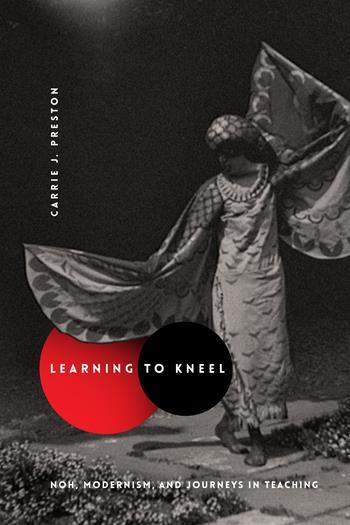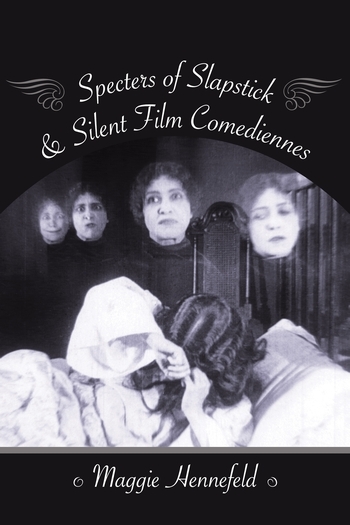An Interview with Carrie Preston, author of "Learning to Kneel"
“My noh training in Tokyo with a master actor changed everything about Learning to Kneel.”—Carrie Preston
The following is an interview with Carrie Preston, author of Learning to Kneel: Noh, Modernism, and Journeys in Teaching
Q: Learning to Kneel examines the Western interest in the Japanese noh theater from many different perspectives, historical and scholarly, as well as via your own experiences as a teacher, student, and performer. How did these different vantage points shape your approach to the book?
Carrie J. Preston: I began thinking about this book as a fairly typical scholarly study of the noh theater’s influence on modernism. As I read previous scholarship on the topic, I kept encountering a disclaimer that went something like this: I tried to watch a noh play but understood next to nothing; that’s ok, there is no need for a deep knowledge of noh because W. B. Yeats, Ezra Pound, Bertolt Brecht, Benjamin Britten, and other Westerners knew nothing about noh. Aside from the homonym fun (nobody knows noh), this was a troubling and decidedly un-scholarly disclaimer. I set out to learn deeply about noh, and I soon realized that experts locate the essence of noh in training, always in private lessons where the student mimics the teacher’s chant and dance so as to memorize the noh repertory. I clearly needed to take lessons, and my experience as a performer helped me undertake this rather daunting enterprise. My noh training in Tokyo with a master actor changed everything about Learning to Kneel.
I decided that the story of my experience taking lessons in noh performance technique needed to be central to the book. I tried to interweave that personal story with the accounts of how the various artists I was discussing learned about noh. I treated us all as noh students who bring personal desires and goals to our studies that impact how we understand and use noh. This approach allowed me to face the disclaimer that none of us know anything about noh by acknowledging that there are always limits to a student’s knowledge. But students also develop unique and interesting strategies for learning. By focusing on the techniques for learning and teaching noh, I hoped to open up the rather esoteric topic of noh theater’s influence on modernism so that the book will be of interest to many students and teachers of cultures—and we are all students and teachers of cultures on some level.
Q: Yeats, Pound, Brecht, and Britten’s approach to noh is often viewed as an example of cultural appropriation. In what ways does your book alter this perception?
CJP: I don’t disagree that these figures were engaged in cultural appropriation and orientalism, but in some ways, that’s the least interesting thing to say about them. It’s easy to accuse them of cultural insensitivity and prove their guilt. At the same time, we often celebrate multiculturalism and diversity, believing that study abroad will produce cultural sensitivity in our students. I find the binary of good multiculturalism and bad appropriation to be particularly unhelpful. Who owns a culture? Who should be allowed to study and perform the theater of a particular culture? What is the difference between being inspired by noh and appropriating noh? If the answer is that only those born into a culture can study, use, or be inspired by it, what does that mean for study abroad, diversity requirements, and global studies?
These are difficult questions, and international/transnational teaching and learning is messy work. In Learning to Kneel, I embrace that mess and get down on my knees in the dirt, so to speak. And that taught me that all cross-cultural or global learning involves a degree of appropriation, whether we’re studying noh or opera. But, of course we don’t put those two lyric musical theaters in the same category because of unequal power relations between the so-called “east,” where noh originated, and “west,” the birthplace of opera. Was Ito Michio appropriating opera when he moved to Germany to become an opera singer? I recognize that power disparities are absolutely crucial to understanding cultural exchange and that some appropriation is regrettably malicious, but I also hope to recognize and question the habits of mind that make us treat noh so differently from opera.
Q: Ito Michio is one of the more fascinating figures in your book. How does his life affect the way we think about cross-cultural exchanges?
CJP: Ito’s life is the perfect example of the messiness of cultural exchange. He traveled to Europe as a young man hoping to become an opera singer and then a western dancer and slough off his stultifying Japaneseness. Upon reaching London, Ito was valued most as an “oriental” artist” by Pound and Yeats, who wanted him to help them translate noh plays and work on modernist noh adaptations. He claimed that they taught him to value his own culture, but they also taught him how valuable the popular fascination with Japan could be for his career as a performer. He began to advertise himself as an “oriental dancer” and exoticize his modern dance practice. When he arrived in New York during World War I, Ito began staging Pound’s translations of noh plays, even though he had no training in noh. And in spite of the fact that he was adapting Pound’s already adapted versions of noh texts, Ito advertised them as absolutely authentic. His tendency to stretch the truth and invent a powerful position for himself in Japan raised the suspicions of the CIA, and he was arrested shortly after the Japanese attacks on Pearl Harbor as an enemy alien. He was eventually repatriated to Japan, where he staged spectacular revues for the U.S. occupying forces and introduced American modern dance and beauty pageants (for better and worse).
Q: How did the Japanese tradition of noh change as a result of the interest of western artists? How does this alter our understanding of tradition?
Ito helps with this question too. He collaborated with Yeats in 1916 on the first noh-inspired play for dancers, At the Hawk’s Well, choreographing and performing the role of the Guardian of the Well. He then took the play on an international tour that circled back to Japan, initially in 1940, when Ito translated and staged the play in Tokyo, during a stay that ignited the CIA’s suspicions. That production also bolstered the Japanese interest in Yeats and in opening up and changing noh institutions. A famous noh scholar named Yokomichi Mario adapted Yeats’s play for Japanese performance in a fairly conventional noh form with Taka no Izumi (1949). Yokomichi then loosened the noh structure in a second adaptation, Takahime (1967). These plays that originated in avant-garde modernist performance experiments have been somewhat controversial in the traditional noh world.
Noh has produced a number of conservative traditions, including the invented tradition that each of the leaders of the noh schools (except for Kita) can trace an unbroken lineage back to the great actor playwright Zeami in the late fourteenth century. Since that time, noh has undergone strict processes of canonization and standardization. But, I’ve found the claim that noh hasn’t changed for centuries on a program that includes Takahime, with mention of Yeats’s collaboration with Ito in 1916.
We, along with our art and entertainment forms, are full of contradictions, some of which get ratified as traditions. To claim that traditions are invented doesn’t mean that they aren’t important; culture itself is a human invention, of course. But, traditions are sometimes treated as if they are only corrupted by cross-cultural exchange. In fact, such exchanges are inevitable, and noh is a product of them. Chinese poetry, music, and performance were primary influences on the development of noh in the early fourteenth century. We should not see cross-cultural exchange or change more generally as always a corrupting influence on tradition.
Q: Turning to your own experiences, what surprised you most about taking noh lessons?
CJP: My first surprise was how much it hurt to kneel totally still in seiza, a formal posture with buns on heels. During a lesson, you kneel in seiza while learning chant (utai), and I could only manage about 15 minutes of the position after practicing a long time. A professional actor will have to sit in seiza for about an hour when performing in the chorus of a play.
My second surprise was how much I began to value that kneeling seiza position as part of the noh lesson. This is obviously the origin of the title, Learning to Kneel. I thought that I would hate this part of noh lessons and even find it humiliating and degrading. Instead, I learned to appreciate the physical and emotional work that the posture was doing on me. Teaching myself to be completely still, even enduring the pain, helped me be receptive to my teacher, to participate in the listen-and-repeat mimicry of the lesson. It also took me out of my mundane world and gave me access to a place of distinction, a place that felt spiritually rich and full. That experience disrupted many of my assumptions about learning and teaching.
Q: How did your noh lessons and your scholarly work on this subject change how you thought about teaching?
CJP: Prior to writing this book and taking noh lessons, I assumed that a casual and egalitarian classroom was better than a more formal and hierarchical one. Good pedagogy, I believed, involved downplaying my authority for the purpose of encouraging students to express views and ask questions. I should never tell a student that their interpretation was incorrect. Noh lessons challenged my assumptions that a student-centered teaching style was an ideal to be achieved by diminishing my expertise and authority and cultivating an informal relationship with students. Why did I think a casual atmosphere, so different from the highly formalized even rarified sensibility of my noh lessons, was more authentic? Power relations shape every pedagogical situation, and it might be more honest to acknowledge them. Noh lessons taught me the pedagogical value of claiming my expertise and authority. By refusing to do so, I was obscuring the very real operations of power in the classroom, including the ritual of grades. My attitude of informality was no more genuine than the rituals of deference I performed for my sensei; both are shaped by conventions. I even realized that my informal act with my students was as much a gendered fear of claiming authority and being disliked as it was a committed feminist pedagogy. I have discovered that I teach best when I demand a level of decorum in my classroom. I don’t make my students drop on their knees in a bow when they enter the classroom, but I do ask them to recognize my authority by addressing me as Professor Preston and writing formal, professional e-mails (with a greeting, complete sentences, and closing for example). These might sound like minor practices, but like gestures in noh lessons, they establish an atmosphere of seriousness, a gravity surrounding teaching and learning.





